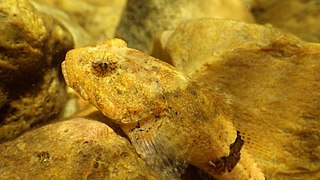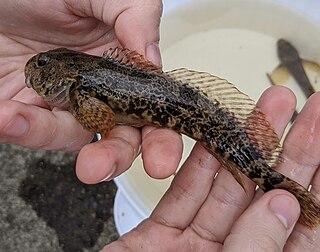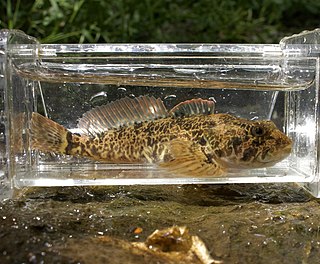
The spoonhead sculpin is a species of freshwater ray-finned fish belonging to the family Cottidae, the typical sculpins. This species is widespread in northeastern North America.

The slimy sculpin is a freshwater species of fish belonging to the family Cottidae, which is the largest sculpin family. They usually inhabit cold rocky streams or lakes across North America, ranging from the Great Lakes, southeast Minnesota, northeast Iowa, southwest Wisconsin and northeast Canada. Slimy sculpins have also been found roaming the cold streams of eastern Siberia. They are commonly confused with their closely related relatives, Mottled sculpin, and with tubenose gobies who are both freshwater fishes as well. The slimy sculpin is a nocturnal fish that usually spends most of its time on the stream bottom and seeks shelter under rocks and logs, especially during spawning season. When it swims, it sometimes appears to be "hopping" along the bottom because of its inefficient ability to swim. This is partly due to the absence of a swim bladder, which normally gives buoyancy to a fish.

Cottus is a genus of the mainly freshwater ray-finned fishes belonging to the family Cottidae, the typical sculpins. They are often referred to as the "freshwater sculpins", as they are the principal genus of sculpins to be found in fresh water. They are native to the Palearctic and Nearctic.

The mottled sculpin is a species of freshwater ray-finned fish belonging to the family Cottidae, the typical sculpins. This species has a wide but scattered North American distribution.

The European bullhead is a freshwater fish that is widely distributed in Europe, mainly in rivers. It is a member of the family Cottidae, a type of sculpin. It is also known as the miller's thumb, freshwater sculpin, common bullhead, and cob.

Cottus petiti, also called the chabot du Lez in French, is a species of freshwater ray-finned fish belonging to the family Cottidae, the typical sculpins. It is endemic to France, found only in a small 3 km stretch of the river Lez in Southern France near Montpellier. The natural habitat is fed by karstic springs which may have enabled the isolated survival of the population through geological history. Now the species may be threatened by habitat loss. The males of this species are typically 56 mm in length. This species was confirmed as a separate species from the European bullhead in 2005 by Jörg Freyhof, Maurice Kottelat and Arne W. Nolte. The specific name honours the zoologist and anatomist Georges Petit (zoologie) of the Muséum national d'Histoire naturelle.

The alpine bullhead or Siberian bullhead is a species of freshwater fish in the family Cottidae of sculpins. It is found in China, the Czech Republic, Denmark, Finland, Germany, North Korea, Moldova, Norway, Poland, Romania, Russia, Slovakia, Sweden, and Ukraine. This fish is listed as being of "Least Concern" by the IUCN.

The fourhorn sculpin is a species of ray-finned fish belonging to the family Cottidae, the typical sculpins. This species has a Holarctic distribution and can be found in marine, brackish and fresh waters.

The long-spined bullhead, also known as the long-spined sea-scorpion, and the long-spined scorpion fish is a coastal fish of the sculpin family Cottidae, inhabiting marine waters of Europe.
Cottus scaturigo, the Timavo sculpin, is a species of freshwater ray-finned fish belonging to the family Cottidae, the typical sculpins. It is endemic to the Timavo Spring in Italy. This species was described as a separate species from the European bullhead in 2005 by Jörg Freyhof, Maurice Kottelat and Arne W. Nolte. However, the Catalog of Fishes treats this taxon as a synonym of Cottus metae, although FishBase treats it as a separate species. The specific name scaturigo means "spouting water", i.e. a spring, an allusion to the Timavo Spring.

The banded sculpin is a freshwater fish dwelling mostly in small to moderate sized streams in areas of swift current. Young and juvenile C. carolinae can mainly be found in pools, riffles, and other shallow habitats while adults tend to prefer deeper waters. C. carolinae primarily eats insects and insect larvae, but their large mouths enable them to eat prey nearly as large as themselves, including other sculpin. To prevent predation, including by other fish, the color and pattern of the sculpin tends to match its environment. Most Cottus carolinae are mottled brown with dark vertical banding and usually reach about three inches in length. They have a broad head which rather quickly narrows into a slim body, giving them the appearance of a tadpole reaching adulthood.
The lollipop darter is a species of freshwater ray-finned fish, a darter from the subfamily Etheostomatinae, part of the family Percidae, which also contains the perches, ruffes and pikeperches. It is endemic to the eastern United States. Lollipop darters are approximately 1.4 to 2.4 inches long.
The wounded darter is a species of freshwater ray-finned fish, a darter from the subfamily Etheostomatinae, part of the family Percidae, which also contains the perches, ruffes and pikeperches. It is endemic to the eastern United States. Its range includes the upper Tennessee River drainage, western Virginia, western North Carolina, and eastern Tennessee. Its typical habitat is among boulders or coarse rubble and cobble, often with overhanging ledges, in medium to large slow-moving rivers. It feeds on small insect larvae, especially midge larvae. Spawning occurs when the water warms up in late spring. Females deposit clutches of adhesive eggs on the underside of rock ledges or slabs, and the male guards the nest. The population trend of this fish seems to be decreasing slowly but it is a relatively common species with numerous sub-populations, and the International Union for Conservation of Nature has assessed its conservation status as being of "least concern". The greatest threat comes from impoundment, and a management plan is in place, including captive breeding.

The Coastrange sculpin is a freshwater sculpin of the genus Cottus. They are commonly found near the ocean in western North America, namely Canada and the United States. It is also known as the Aleutian sculpin.

The prickly sculpin is a species of ray-finned fish belonging to the family Cottidae, the typical sculpins. It is native to the river drainages of the Pacific Slope of North America from Seward, Alaska south to the Ventura River of Southern California. It extends east of the Continental Divide in the Peace River of British Columbia. It has also been introduced to several reservoirs in Southern California.

The Blue Ridge sculpin is a species of sculpin in the family Cottidae. It is native to the eastern United States, where it can be found in a number of river systems that drain into the Atlantic.

Artedius fenestralis, the padded sculpin, is a species of marine ray-finned fish belonging to the family Cottidae, the typical sculpins. The species is native to the eastern Pacific Ocean, with a range extending from the Alaska Peninsula to Southern California. It grows to a maximum length of 14 centimeters and subsists on a diet of shrimp and small fishes. A. fenestralis is commonly found in rocky intertidal and subtidal habitats, particularly near kelp forest edges.

The Paiute sculpin is a species of fish in the family Cottidae. It is found in the United States, inhabiting the Columbia River drainage from Idaho, western Wyoming, and northeastern Nevada to western Washington and Oregon, and endorheic basins including Lake Tahoe in Nevada and California. It reaches a maximum length of 13.0 cm. It prefers rubble and gravel riffles of cold creeks and small to medium rivers. It is also found in rocky shores of lakes. Paiute sculpin are benthic organisms, residing at the bottom of their environments.
The shorthead sculpin is a species of fish in the family Cottidae. Shorthead sculpins are small, bottom-dwelling fish, typically measuring around 13 to 15 cm in length. They have large heads, fanlike pectoral fins, and a narrow caudal peduncle. Their physical characteristics include 7–9 dorsal spines, 15–19 dorsal soft rays, 10–14 anal soft rays, and palatine teeth. Their coloration is a mix of dark brown and yellow.

The coastal riffle sculpin is a species of freshwater ray-finned fish belonging to the family Cottidae, the typical sculpins. It is endemic to the Coast Range Mountains of California, where it is found in streams draining to the west and southwest. This taxon was considered to be conspecific with the inland riffle sculpin until research published in 2020 by Peter B. Moyle and Matthew A. Campbell showed that it was a separate valid species which was split into two subspecies. One, C.o. pomo, found in the northern Russian River and north San Francisco Bay drainage; and the other, C.o. ohlone, in the southern Santa Clara Valley. The specific name honors the Ohlone people, a Native American group which lived around southern San Francisco Bay and the Santa Clara Valley. The Ohlone name refers to a group of over 50 people who interacted in these areas. It is not listed with a conservation status under the Endangered Species Act.















